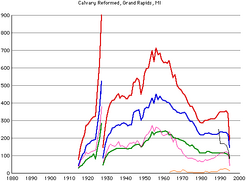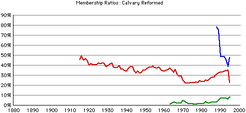History[]
Common Ground Community was organized as Calvary Reformed Church in 1915 as a daughter church of Third Reformed and Bethany Reformed. The congregation grew quickly under its fourth pastor, Dr. Martin R. De Haan, a physician who had been transformed from a faithful, life-long church member into a passionate disciple of Jesus Christ by a near-death experience at the age of 30. In his own words, "After a life of sin for 30 years I was born again of the Spirit in October 1921. Since then, my only hope and aim is to exalt Him, to whom be all glory forever and ever."
Less than a year later he decided to sell his medical practice and begin study for the pastorate at Western Theological Seminary in Holland, Michigan. He graduated in 1925, and Calvary Reformed was his first pastorate. His passionate preaching drew crowds, but some of his teachings were outside of the Reformed tradition: De Haan believed that infants should not be baptized; only believers should be baptized, and that should be done by full immersion. He also promoted the premillenial view that Christ's second coming would precede a literal 1,000 year reign on earth.
De Haan came to dispute Reformed beliefs, and he was deposed as a Reformed Church pastor in 1929. De Haan led the vast majority of the congregation to form Calvary Undenominational Church (now simply Calvary Church) in 1929. He served as its pastor until 1938, when he resigned and went on to found Radio Bible Class (now RBC Ministries).
The sanctuary could seat 1,000 during the De Haan era and achieved a total membership of 900 before he was deposed. Despite the departure of De Haan and 80% of its members, Calvary continued to grow until the mid 1950s.
The sanctuary was remodeled in the 1960s with much of the balcony converted to classroom space and seating for 500, which was much more in line with membership. By 1980, total membership had dropped below 300; that was followed by neary 15 years of slow growth.
The church went through a "restart" in 2000 and adopted the name Common Ground Community Church. The "new" church began to worship in the Forest Hills Northern high school auditorium on Sept. 24, 2000 and moved to the original Calvary location on Sept. 16, 2001.
One interesting tidbit: The church doesn't have a parking lot!
Historical Details[]
Names[]
- Calvary Reformed Church, 1915-2000
- Common Ground Community Church, 2000-present
Location[]
- 1515 East Fulton
- Forest Hills Northern high school (2000-2001)
Pastors
- Clarence P. Dame, 1916-18
- Andrew Stegenga, 1918-19
- Miner Stegenga, 1919-24
- Martin R. De Haan, 1925-29, founder of Calvary Undenominational Church
- Jacob Prins, 1929-34
- Harry L. Brower, 1935-41
- Jerry A. Veldman, 1943-48
- George C. Douma, 1949-57
- Donald K. Blackie, 1958-66
- Peter J. Breen, 1967-79
- James G. De Witt, 1979-present
- Tom Archer, 1996-present
Daughter Churches[]
- Calvary Undenominational (indirectly), 1929
- Eastmont/Forest Hills Community, 1955-75
Membership Overview[]

Membership data, Common Ground Community, Grand Rapids, MI
Membership Data[]
Rev. Martin R. De Haan was deposed in 1929. Over eighty percent of the congregation followed him to found Calvary Undenominational Church.

Membership ratios, Common Ground Community, Grand Rapids, MI
Membership Ratios[]
Red line (middle) shows nonprofessing members as a percentage of total membership (inactive members exluded); green (lower), inactive members as percentage of total membership; and blue (higher) average worship attendance of total membership.

Five year growth rate, Common Ground Community, Grand Rapids, MI
Five Year Growth Rate[]
Red line shows five year growth rate. A five year growth rate between 10% and -10% is considered stable; greater than 10% indicates a growing congregation; one below -10% indicates a church in decline. This makes no allowance for daughter churches.
Heavy lines: green (lower) shows membership in families; blue (middle), professing members; red (top), total members. Thin lines: magenta (middle), non-professing members; orange (lower), inactive members; black (top), average worship attendance.
Data source: Acts of Synod of the Reformed Church in America. Dates are year prior to publication date since data is gathered at the end of one year and published in the next.